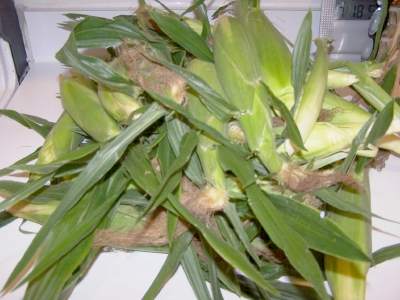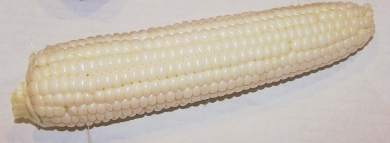
Looking for How tp grow your own corn! in 2024? Scroll down this page and follow the links. And if you bring home some fruit or vegetables and want to can, freeze, make jam, salsa or pickles, see this page for simple, reliable, illustrated canning, freezing or preserving directions. There are plenty of other related resources, click on the resources dropdown above. If you are having a hard time finding canning lids, I've used these, and they're a great price & ship in 2 days.
If you have questions or feedback, please let me know! There are affiliate links on this page. Read our disclosure policy to learn more.
How tp grow your own corn!
Grow your own corn!
 Corn, also called "sweetcorn" to distinguish it from field corn
(which is used as animal feed) and popcorn, is easy to grow. Here is our guide on how to select and harvest sweet corn for home use:
Corn, also called "sweetcorn" to distinguish it from field corn
(which is used as animal feed) and popcorn, is easy to grow. Here is our guide on how to select and harvest sweet corn for home use:
- Choosing the right sweet corn variety:
- Select a sweet corn variety that suits your taste preferences and growing conditions. Consider factors such as maturity time, disease resistance, and yield. In general you want a strong hybrid variety And of course, your choice of colors: yellow, white, or mixed (bicolor). My preference is white corn, and Burpee's improved Silver Queen, called Silver Choice or Silver Bullet, are my favorites. They are strong plants that produce 2 or 3 ears per plant. - Planting and caring for
sweet corn:
- Prepare the soil by adding organic matter and ensuring good drainage. Huge amounts of compost, rotted manures, leaves and grass clippings work great. Add some slo lime to control acidity.
- Timing is everything. If the ground is not warm enough or is waterlogged, the seeds will simply rot. So, wait a couple of weeks past the last frost date!
- Sow corn seeds directly in the garden, about 1/2 to 1 inch deep . TIP: water, then lay a board, weed fabric or plastic over the plated row to keep the seeds from drying out and to keep birds, mice, squirrels, etc from eating the seeds.
- Provide adequate water to the plants, especially during dry periods. Corn needs loads of water!~
- Control weeds by mulching with leaves, grass clippings, weed fabric, etc or carefully cultivating around the plants.-
- Weed fabric between the rows works great! - Pests and vermin:
- Monitor for pests and diseases, and use an organic pesticide like Spinosad or pyrethrin to manage them.
- The biggest problem is corn ear borers, ear worm. The control is simple: just spuirt Spinosad or pyrethrin on the silks every 4 days once the silks appear and until they turn brown.
- Raccoons and Squirrels can devastate a crop overnight. If they are present in your area, it's best to use Hav-a-hart traps baited with peanut butter and apple slices to trap them and move them MILES away. Start trapping a month before you plant! - Determining corn maturity:
- Sweet corn is ready for harvest when the ears reach the right stage of maturity. Look for the following signs:
- Silk color: The silk strands at the top of the ear should be brown and dry.
- Kernel plumpness: Gently press your thumbnail into a kernel; if a milky fluid spurts out, the corn is ready.
- Ear size: The ears should be filled out and have developed good girth. - Harvesting sweet corn:

- Harvest time can vary based on the variety, so check the seed packet or consult local resources for specific maturity details.
- To harvest, firmly hold the corn stalk and pull the ear downward in a swift, smooth motion.
- Avoid twisting or yanking the ears, as this can damage the stalk or the ear itself.
- Harvesting is usually done in the early morning or late evening when the temperature is cooler.
- Post-harvest handling:
- After harvesting, it's important to consume or store sweet corn promptly to maintain its freshness: immediately cool it down, get it in the fridge or ice it!
- Remove the husks and silks from the ears.
- Use corn immediately for the best taste, as the sugars start to convert to starch soon after harvest. Always use or blanch and freeze corn within 24 hours of harvest.
- If you have more corn than you can eat, consider freezing or canning it to enjoy throughout the year.
Remember, the sweetness and flavor of sweet corn are at their peak right after harvest. By following these steps, you can ensure that you select and harvest sweet corn at the right time for optimal taste and enjoyment in your home.
Looking for canning equipment and supplies?
Water bath canner with a jar rack
Pressure canners for gas, electric and induction stoves: Presto 23Qt or T-fal 22Qt
Canning scoop (this one is PERFECT)
Ball Blue book (most recent version)
Find Other types of farms:
- Easter egg hunts
- Children's consignment sales
- Farm markets and roadside stands
- Road trips and camping resources
- Local Honey, apiaries, beekeepers
- Local Meat, Milk and Eggs
- Consumer fraud and scams information
- Home canning supplies at the best prices on the internet!
- Maple Syrup Farms, sugarworks, maple syrup festivals
- Environmental information and resources
- Farms For Your Event for birthday parties, weddings, receptions, business meetings, retreats, etc.
- Festivals - local fruit and vegetable festivals
- Pumpkin patches and corn mazes
- Christmas Tree Farms and lots
Get the
most recent version of
the Ball Blue Book
Get the
most recent version of
the Ball Blue Book of Home Canning
Find other types of farms:
- Easter egg hunts
- Children's consignment sales
- Farm markets and roadside stands
- Local Honey
- Local Meat, Milk and Eggs
- Road trip and camping
- Pumpkin patches and corn mazes
- Christmas Tree Farms and lots
- Maple Syrup farms and sugarworks
Highly rated canning supplies:
- Regular Mouth Canning Lids with food-grade with BPA Free Silicone seals for Ball, Kerr Jars for Canning
- Canning accessories kit: funnel, jar tongs, lid lifter, etc
- Food Dehydrator, 400W Electric with 8 Trays, 48 hour Timer and Temperature Control 95-176℉, BPA-Free
- Water Bath Canner, 21 Qts with lid, Jar Rack, Speckled Black, cans 7 quart jars, 9 pint jars or 13 half-pint jars
- Air Fryer: Instant Pot Instant Vortex Plus XL 8QT Clear Windows, Custom Programming, 8-in-1 Functions that Crisps, Broils, Roasts, Dehydrates, Bakes, Reheats
- Pressure canner: All American 921, 21.5qt Pressure Cooker/Canner, never needs gaskets, Great for Gas, Electric or Flat Top Stoves - Made in the USA
- The Backyard Homestead:a guide to homesteading , on 1/4 acre, how to raise grains and vegetables; raise animals for meat, eggs, and dairy; and keep honey bees
- Smart silent HEPA Air Purifiers for Home, Large Rooms for Allergies, Smoke, Pets. Eliminates 99.97% of Dust, Pet Hair, Odors


